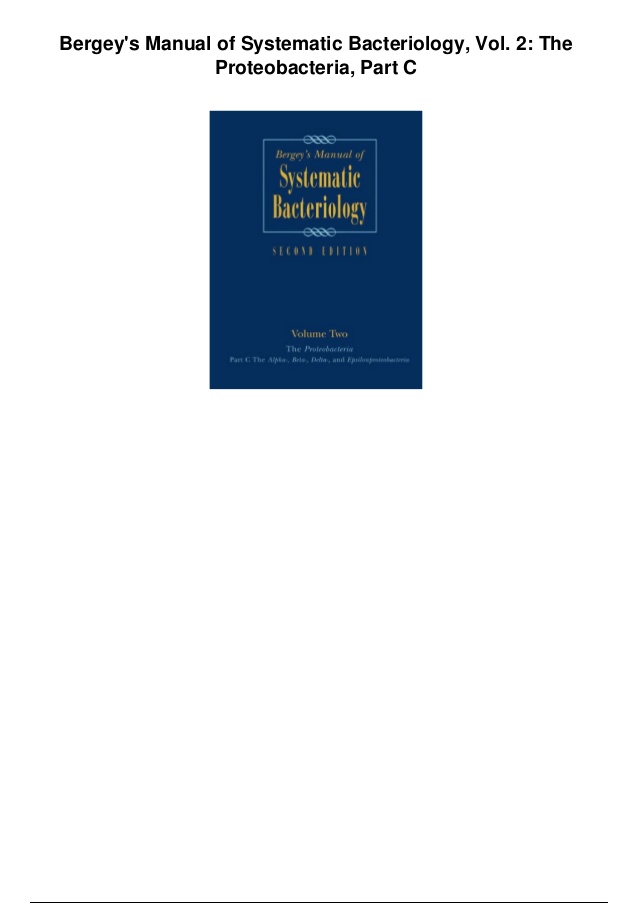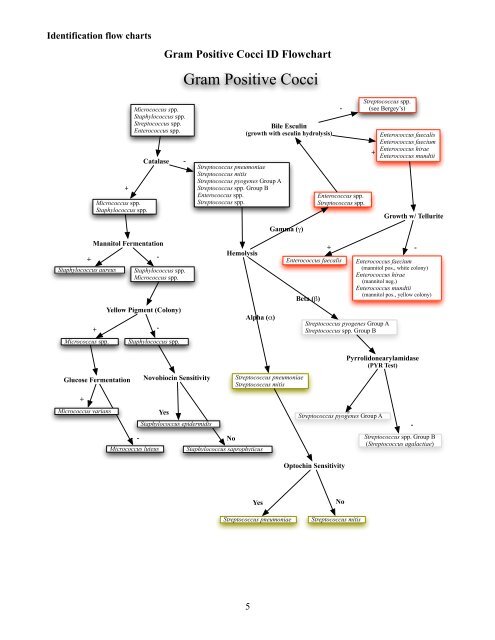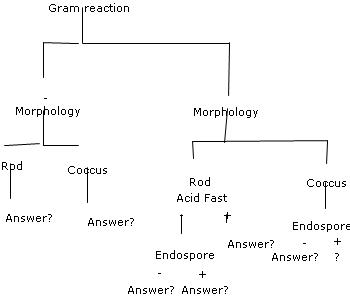- Bergey's Manual Flow Chart
- Bergey's Manual Chart Gram Positive Rod
- Bergey's Manual Identification Chart
- Bergey's Manual Chart
- Bergey's Manual Chart
- Bergey's Manual Chart

The following points highlight the top four Volumes of Bergey’s Manual of Systematic Bacteriology.
- Bergey's Manual of Systematic Bacteriology. Download Full PDF Package. A short summary of this paper. 37 Full PDFs related to this paper. Bergey's Manual of Systematic Bacteriology. Bergey's Manual of Systematic Bacteriology.
- The organization of Bergey's Manual of Systematic Bacteriology makes it impractical for helping place unknown bacteria into major taxa, but it contains far more detail on the families, genera, and species and is far more up to date than the Determinative manual. You will need to consult this information in order to double check and finalize.
Bergey’s Manual of Systematic Bacteriology # Volume I:
Section 1: The spirochetes
Order I. Spirochaetals.
ADVERTISEMENTS:
Family I. Spirochaetaceae e.g., Spirochaeta.
Family II. Leptospiraceae e.g., Leptospira.
Identification flow charts 1 Bergey’s Manual of Determinative Bacteriology All of the unknowns will fall into the following groups in Bergey's Manual of Determinative Bacteriology (The pink book on the shelf in the laboratory). Landcare Research New Zealand Ltd., Mt. Albert Research Centre, Private Bage 92 170, Auckland, New Zealand. Search for more papers by this author.
Section 2: Aerobic, microaerophilic, motile, helical, vibroid, Gram negative curved bacteria, e.g., Aquaspirlllum, Azospirillum, spirillum .
Section 3: Normotile (or rarely motile), Gram negative curved bacteria.
Family I: Spirosomaceae, e.g., spirosoma.
Section 4: Gram negative aerobic rods and cocci.
Family I: Pseudomonadaceae e.g., Pseudomonas.
Family II: Azotobacteraceae e.g., Azotobacter.
Family III: Rhizobiaceae e.g., Rhizobium.
Family IV : Methylococcaceae e.g., Methylococcus.
Family V : Halobacteriaceae e.g., Halobacterium.
Family VI: Acetobacteriaceae e.g., Acetobacter.
Family VII: Legionellaceae e.g., Legionella.
ADVERTISEMENTS:
Family VIII: Neisseriaceae e.g., Neisseria, Beizeriuckia.
Section 5: Facultatively anaerobic Gram-negative rods e.g.,
Family I: Enterobacteriaceae e.g., Escherichia, shigella, salmonella, klbsiella, Yersia.
Family II: Vibrionaceae, e.g., Vibrio.
Family III: Pasteuellaceae e.g., Actinobacillus Haemophilus.
Section 6: Anaerobic Gram negative straight, curved and helical rods.
Family I: Bacteroidaceae e.g., Bacteroides.
Section 7: dissimilatory sulphate or sulphur reducing bacteria e.g., Desulfuromonas, Desulfobacter.
ADVERTISEMENTS:
Section 8 : Anaerobic Gram-negative cocci.
Family I: Veillonellacae e.g.,veillonella.
Section 9: Rickettsias and chlamydia orders
Order I: Rickettsiales.
Family I: Rickettsiaceae e.g., Rickettsia.
Family II: Bartonellaceae e.g., Bartonella.
Family III: Anaplasmtaceae e.g., Anaplasma
Section 10: Order I: Mycoplasmatales
Family I: Mycoplasmataceae e.g., Mycoplasma, ureoplasma.
Family II: Acholeplasmataceae e.g., Acholeplasma.
ADVERTISEMENTS:
Family III: Spiroplasmataceae e.g., spiroplasma.
Section 11: Endosymbiont.

A . Endosymbiont of Protozoa, Ciliates, Flagellates, amoebae.
B . Endosymbiont of insects .
C . Endosymbiont of fungi and invertebrates other than arthropods.
Bergey’s Manual of Systematic Bacteriology # Volume II:
Section 12: Gram positive cocci.
Family I: Micrococcaceae e.g., Micrococcus
Family II: Deinococcaceae e.g., Deinococcus.
Section 13: Endospore forming Gram-positive rods and cocci e.g., Bacillus, Clostridium.
Section 14: Regular, non-sporing, Gram positive rods e.g., Lactobacillus, Renibacterium.
Section 15: Irregular, non-sporing, Gram-positive rod, e.g., corynebacterium, Microbacterium.

Section 16: The Mycobacteria.
Family: Mycobacteriaceae e.g., Mycobacterium
Section 17: Nocardioforms e.g., Nocardia, rhodococcus.
Bergey’s Manual of Systematic Bacteriology # Volume III:
Section 18: Anoxygenic phototrophic bacteria.
Bergey's Manual Flow Chart
(I) Purple bacteria
Family I: Chromatiaceae e.g., chromatium .
Family II: Ectothiorhodospiraceae, Ectothiorhodospira.
(II) Purple Non sulphur bacteria Rhodospirillum, Rodobacter.
(III) Green Bacteria:
Green sulphur bacteria e.g., chlorobium, chloroberpeptone.
(IV) Multicellular, Filamentous, green bacteria e.g., Chloroflexus, heliothrix.
(V) Genera Incertae sedis Heliobacterium, Erytherobacter.
Section 19: Oxygenic photosynthetic bacteria Cyanobacteria.
Family I: Chrococcaceae.
Family II: Pleurocapraceae.
Family III: Oscillatoriaceae e.g., spirulina, oscillatoria
Family IV : Nostocaceae e.g., Anabena, Nostoc.
Family V: Stigonemataceae e.g., Chlorogloeopsis.
B: Prochloraceae e.g., Prochloron.
Section 20: Aerobic Chemolitholrophic bacteria and associated organisms.
A. Nitriflying bacteria.
Family: Nitrobaacteriaceae e.g., Nitrobacter, Nitrococcus, Nitrosomonas.
B. Colourless Sulphur bacteria, e.g., Thiobacterium, Macromonas, Thiospira.
C. Obligately chemolithtrophic, Hydrogen bacteria e.g., Hydrogenobacter.
D. Iron and manganese oxidizing and/or depositing bacteria e.g.,
Family: Siderocapsaceae e.g., Siderocapsa.
E. Magnotactic bacteria, e.g., Aquaspirillum, Maganotacticum.
Section 21: Budding and/or Appendaged bacteria
1. Prosthecate Bacteria.
A. Budding Bacteria, Genus, Hyphomonas, Prosthecomicrobium.
Bergey's Manual Chart Gram Positive Rod
B. Non budding bacteria, Caulobacter, Prosthecobacter.
2. Nonprosthecate bacteria.
Bergey's Manual Identification Chart
A. Budding bacteria lack peptidoglycan, planctomyces, contain peptidoglycan e.g., Blastobacter.
B. Non-budding bacteria e.g., Galionella, Nevskia.
Section 22: Sheathed Bacteria, e.g., Sphaerotilus, Leptothrix, clonothrix.
Section 23: Nnphotsynthetic, non-fruiting Gliding bacteiua.
Family I: Cytophagaceae, e.g., cytophaga.
Family II: Lysobacteriaceae e.g., Lysobacter.
Family III: Beggiatoaceae e.g., Beggiatoa, Thiothrix, Thioploca.
Other families:
Family: Simonriellaceae e.g., Simonsiella.
Family: Pelonemataceae, e.g., pelonema.
Section 24: Fruiting Gliding bacteria (Myxobacteria).
Family I: Myxococcaceae e.g., Myxococcus.

Family II: Archangiaceae e.g., Archangium.
Family III: Cystobacteriaceae e.g., Cystobacter.
Family IV : Polyangiaceae e.g., Polyangium.
Section 25 : Archaebacteria.
Group I : Methanogenic archae bacteria.
Family I: Methanobacteraceae e.g., Methanobacterium.
Family II: Methanothermaceae e.g., Methanthermus.
Family III: Methanomicrobiaceae e.g., Methanomicrobium.

Family IV : Methanosarcinaceae e.g., Methanosarcina.
Family V : Methanplanaceae e.g., methanoplanus.
Group II : sulphate reducer Archace bacteria.
Bergey's Manual Chart
Family : Archaeoglobaceae e.g., Archaeoglobus.
Group III: Extrenely halophilic Archaebacteria.
Bergey's Manual Chart
Family : Halobacteriaceae e.g., Halobacterium.
Bergey's Manual Chart
Group IV : Cell wall less archaebacteria.
Family: Thermoplasmaceae.
Group V: Extremely thermophilic sulphate metabolizers. Family: Thermococcaceae e.g.,Thermocccus.
Bergey’s Manual of Systematic Bacteriology # Volume IV:
Section 26: Nocardioform actinomeycetes e.g., Nocardia, Rhodococcus.
Section 27: Actinomycetes with multi-locualar sporangia e.g.,. Frankia, Dermatophilus.
Section 28: Actinoplanetes e.g., Actonoplanes, Micromonospora.
Section 29: Streptomycetes and related genera a e.g., streptomyces, Kineosporia.
Section 30: Maduromycetes, e.g., actinomadura, Streptosporangium.
Section 31: Thermomonospora and related genera e.g., Nocardiopsis.
Section 32: Thermactinomycetes e.g., Thermoactimoneyces.
Section 33: Other genera e.g., Glycmyces, Pasteuria, Saccharothrin.